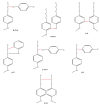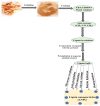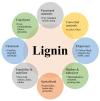Recent Advances in Synthesis and Degradation of Lignin and Lignin Nanoparticles and Their Emerging Applications in Nanotechnology
- PMID: 35160893
- PMCID: PMC8838035
- DOI: 10.3390/ma15030953
Recent Advances in Synthesis and Degradation of Lignin and Lignin Nanoparticles and Their Emerging Applications in Nanotechnology
Abstract
Lignin is an important commercially produced polymeric material. It is used extensively in both industrial and agricultural activities. Recently, it has drawn much attention from the scientific community. It is abundantly present in nature and has significant application in the production of biodegradable materials. Its wide usage includes drug delivery, polymers and several forms of emerging lignin nanoparticles. The synthesis of lignin nanoparticles is carried out in a controlled manner. The traditional manufacturing techniques are costly and often toxic and hazardous to the environment. This review article highlights simple, safe, climate-friendly and ecological approaches to the synthesis of lignin nanoparticles. The changeable, complex structure and recalcitrant nature of lignin makes it challenging to degrade. Researchers have discovered a small number of microorganisms that have developed enzymatic and non-enzymatic metabolic pathways to use lignin as a carbon source. These microbes show promising potential for the biodegradation of lignin. The degradation pathways of these microbes are also described, which makes the study of biological synthesis much easier. However, surface modification of lignin nanoparticles is something that is yet to be explored. This review elucidates the recent advances in the biodegradation of lignin in the ecological system. It includes the current approaches, methods for modification, new applications and research for the synthesis of lignin and lignin nanoparticles. Additionally, the intricacy of lignin's structure, along with its chemical nature, is well-described. This article will help increase the understanding of the utilization of lignin as an economical and alternative-resource material. It will also aid in the minimization of solid waste arising from lignin.
Keywords: degradation; lignin; ligninolytic enzymes; nanobioremediation; nanoparticles.
Conflict of interest statement
The authors declare that there is no conflict of interest.
Figures








References
-
- Arapova O.V., Chistyakov A.V., Tsodikov M.V., Moiseev I.I. Lignin as a Renewable Resource of Hydrocarbon Products and Energy Carriers (A Review) Pet. Chem. 2020;60:227–243. doi: 10.1134/S0965544120030044. - DOI
-
- Arora A., Nandal P., Singh J., Verma M.L. Nanobiotechnological advancements in lignocellulosic biomass pretreatment. Mater. Sci. Energy Technol. 2020;3:308–318. doi: 10.1016/j.mset.2019.12.003. - DOI
Publication types
LinkOut - more resources
Full Text Sources

